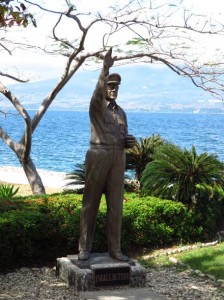 Corregidor Island is one of those Must-Do trips on the tourist trail around Manila. But it requires a ridiculously early start, at which I have baulked for years. Recently, however, I jumped at the opportunity to join a small group of friends and brave the waves across Manila Bay to see what all the fuss was about.
Corregidor Island is one of those Must-Do trips on the tourist trail around Manila. But it requires a ridiculously early start, at which I have baulked for years. Recently, however, I jumped at the opportunity to join a small group of friends and brave the waves across Manila Bay to see what all the fuss was about.
Corregidor is the largest of five tiny islands clustered around the mouth of Manila Bay, a mile off the southern end of the Bata’an Peninsula. Measuring 900 hectares, its distinctive shape is often described as a tadpole, but twist it around and it looks like a crab’s claw snapping at invaders. However you see it, Corregidor has played a significant role in Filipino history, particularly during World War II.
Once upon a time, Corregidor was home to a small Filipino fishing village. Later, under Spanish rule, it became a fortress, a jail, and a customs post. Then, at the end of the nineteenth century, the Americans arrived. Realizing the strategic significance of the Philippines, the United States government made a huge military commitment to the region. This included the fortification of Corregidor Island and the training of a large Philippine Army. Together with El Fraile island (Fort Drum), Caballo Island (Fort Hughes) and Carabao Island (Fort Frank), these islands became deadly weapons with which to defend Manila.
As we headed out to sea on a Sun Cruises catamaran packed with sight-seers, we were shown an introductory film about the island, largely focusing on World War II footage. Bombs exploded and aircraft dived into the sea accompanied by a nauseating B-grade commentary reeking of wartime propaganda, but it filled in the time.
Landing on the island after a comfortable hour and a half at sea, we were greeted by a large bronze statue of the 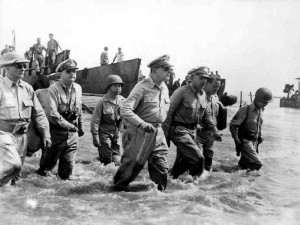 notorious General MacArthur, who sat out the war in Melbourne after being driven out of Manila by the Japanese in 1941, and fleeing to Australia in February 1942, after holing up on Corregidor for ten weeks. In true Hollywood style he announced to the press in that well-known speech: from South Australia ‘I came through and I shall return.’ Apparently, Washington asked MacArthur to amend this to ‘We shall return,’ which he ignored. Despite his somewhat ignominious retreat, MacArthur became the symbol of the Allied forces resisting the Japanese, and would receive many accolades ‘to offset any propaganda by the enemy directed at his leaving his command’ Today his image stands proudly at the dock, hailing the Philippines, as on the day he kept his word and came back to rout the Japanese, wading through the see at Leyte three times to create that iconic photograph captioned ‘I have returned.’
notorious General MacArthur, who sat out the war in Melbourne after being driven out of Manila by the Japanese in 1941, and fleeing to Australia in February 1942, after holing up on Corregidor for ten weeks. In true Hollywood style he announced to the press in that well-known speech: from South Australia ‘I came through and I shall return.’ Apparently, Washington asked MacArthur to amend this to ‘We shall return,’ which he ignored. Despite his somewhat ignominious retreat, MacArthur became the symbol of the Allied forces resisting the Japanese, and would receive many accolades ‘to offset any propaganda by the enemy directed at his leaving his command’ Today his image stands proudly at the dock, hailing the Philippines, as on the day he kept his word and came back to rout the Japanese, wading through the see at Leyte three times to create that iconic photograph captioned ‘I have returned.’
On the dock, we clambered onto a small, open-air bus-in-tram’s-clothing, and drove up from the quay to Topside. Like a steak, the island is imaginatively zoned Topside, Middleside, Bottomside and Tailside. With great excitement, we glimpsed a small macaque squatting under the trees, watching us cautiously. Apparently there are plenty of these tiny monkeys living on the island, but they kept a low profile and this was the only one we saw all day. The deer and monitor lizards stayed in the shadows too. However, there were geckoes in abundance, including a giant pair breeding amongst the ruins.
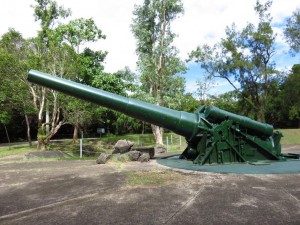 Our guide had a passion for the facts and figures of World War II and a plethora of puns and quips to keep the commentary light and breezy. He also had a private supply of memorabilia garnered from the forest floor, and he delighted in taking us off the beaten track. I must admit, my memory for such detail is a little hazy, but I enjoyed the irony behind the origin of Fort Mills: built with reinforced concrete straight from Japan, and apparently strong enough to withstand hurricanes, it was not, however, strong enough to withstand Japanese bombs. Twenty thee gun batteries were installed on the island, the 14 ton guns made in Pennsylvania’s heart-of-steel at Bethlehem, and many of them were blown literally sky high when the Japanese bombers flew in, direct from their rendez-vous with Pearl Harbour on December 7 1941.
Our guide had a passion for the facts and figures of World War II and a plethora of puns and quips to keep the commentary light and breezy. He also had a private supply of memorabilia garnered from the forest floor, and he delighted in taking us off the beaten track. I must admit, my memory for such detail is a little hazy, but I enjoyed the irony behind the origin of Fort Mills: built with reinforced concrete straight from Japan, and apparently strong enough to withstand hurricanes, it was not, however, strong enough to withstand Japanese bombs. Twenty thee gun batteries were installed on the island, the 14 ton guns made in Pennsylvania’s heart-of-steel at Bethlehem, and many of them were blown literally sky high when the Japanese bombers flew in, direct from their rendez-vous with Pearl Harbour on December 7 1941.
Their plan was to neutralize America’s role in the war, and they were initially so successful that MacArthur was forced to evacuate Manila less than three weeks later, removing Army headquarters and the Filipino government to Corregidor and withdrawing the troops to Bataan. By 31st December, MacArthur had gone to ground on Corregidor with 8,000 soldiers and hospital staff holed up beneath 300 feet of the solid rock. Hospital staff, realizing that the hospital would be a prime target despite the Red Cross on its roof, had managed to gather up all their patients in the hours before the Japanese arrived from Pearl Harbor, and carried them into the tunnels where they survived as best they could in the dank and claustrophobic atmosphere.
Meanwhile, the huge guns installed on the island were being used to defend the island, but as it turned out, they provided little protection against the heavy shelling of the Japanese artillery. One direct hit on May 2 detonated the magazines of Battery Geary, causing an explosion that blew one fifty ton mortar barrel through three feet of reinforced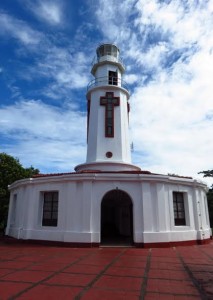 concrete wall into the adjoining powder magazine of Battery Crockett. Large chunks of steel flew from another, killing 27 of the battery crew instantly. Today, one remaining mortar still holds a live round in its breech, and many tourists peer into the dark mouth with a shiver.
concrete wall into the adjoining powder magazine of Battery Crockett. Large chunks of steel flew from another, killing 27 of the battery crew instantly. Today, one remaining mortar still holds a live round in its breech, and many tourists peer into the dark mouth with a shiver.
Today, Corregidor is like a scene from Indiana Jones, the ruins draped in jungle and tethered by Strangler Fig. Bullet holes riddle heavy metal doors while bomb craters have become a feature of the landscape. War souvenirs still continue to emerge like buried treasure from the jungle, thanks to the persistent searches of war buffs: buttons and medals, dog tags and coins are on public display at the museum, while guides are always delighted to show off their own private collections.
On the highest point of Topside is the Pacific War Memorial to honour the Filipino and American soldiers who fought in World War II. Beyond the memorial stands the Eternal Flame of Freedom, a 40 foot weathered steel structure designed by American sculptor, Aristides Demetrios.
We climbed to the top of the lighthouse on Topside for amazing views across the island and out to sea. A lighthouse has stood on this spot since 1853, but the original lighthouse was irreparably damaged during the Siege of Corrigedor in 1941-2 and needed to be totally reconstructed in the 1950s.
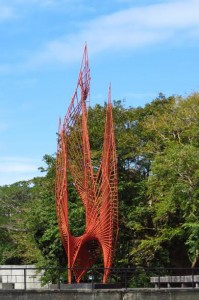 As we roamed over the island, I sat on the bus and tried to imagine life here before the war. Clambering through the ruins of the vast hospital, or driving past the Mile Long Barracks, it quickly became clear that a posting to Corregidor in the early twentieth century would have been a cushy little number. Who would argue with an army posting to a tropical island that was decked out like a beach resort, with free trams, a golf course, a high school and Olympic Pool, duty free and cheap-as-chips staff? Four thousand American soldiers could live like kings on this five star island, accompanied by 4,000 Filipino soldiers and a large local support staff.
As we roamed over the island, I sat on the bus and tried to imagine life here before the war. Clambering through the ruins of the vast hospital, or driving past the Mile Long Barracks, it quickly became clear that a posting to Corregidor in the early twentieth century would have been a cushy little number. Who would argue with an army posting to a tropical island that was decked out like a beach resort, with free trams, a golf course, a high school and Olympic Pool, duty free and cheap-as-chips staff? Four thousand American soldiers could live like kings on this five star island, accompanied by 4,000 Filipino soldiers and a large local support staff.
A far cry from the stultifying existence in the Malinta Tunnels during the 1940s, where no natural light could find an entry, and only a handful of air vents could bring fresh air into the airless tunnels. Wounded soldiers lining the tunnel walls, limited latrines, and the ever-present cigarette smoke thickened what air there was. Empty, the tunnels are quite broad and high, but crammed with hospital beds and thousands of soldiers and hospital staff trapped like rabbits and listening helplessly to the heavy bombardment above their heads, knowing they were running out of food and ammunition, it must have felt both suffocating and petrifying.
Our final stop was the controversial Japanese Garden of Peace, built as a memorial to the Japanese soldiers who fought and died on the island during WWII, completing the circle of Corregidor as a memorial to war: to the death and destruction and its effects on both sides, and the ongoing hope that such horrific scenes will never be repeated.
*With thanks to June Vann for her fabulous photos, and to Google Images for “I have returned,” and adapted from an article first published for ADBSA Newsflash, March 2015.
